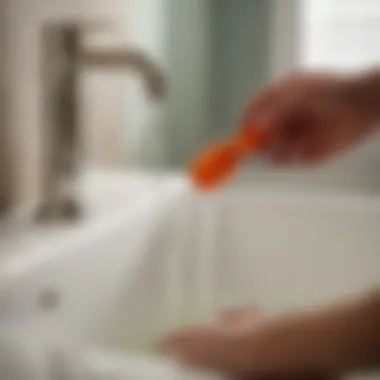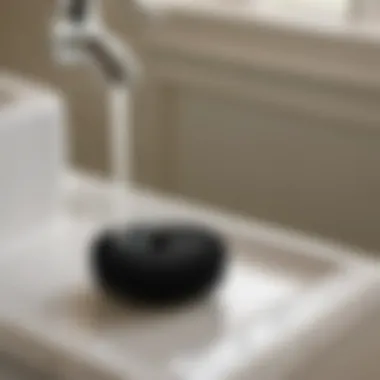Efficient Techniques to Unclog Your Bathroom Sink: A Comprehensive Guide


Materials:
- 1 cup of baking soda
- 1 cup of white vinegar
- 1 pot of boiling water
- Several old rags
- Rubber gloves
DIY Steps:
- Step 1: Boil Water Start by boiling a pot of water on the stove. Make sure it's not too hot to avoid scalding.
- Step 2: Baking Soda & Vinegar Solution Pour one cup of baking soda down the drain, followed by one cup of white vinegar. Let the solution fizz and work for about 10-15 minutes.
- Step 3: Flush with Boiling Water After the fizzing has subsided, carefully pour the pot of boiling water down the drain. This helps wash away the loosened clog.
Technical Aspects:
- Tools: Pot for boiling water, measuring cup, old rags
- Timing: Allow 10-15 minutes for the baking soda & vinegar solution to work. The total process should take around 30 minutes.
- Critical Techniques: Ensure not to mix the baking soda and vinegar directly in a closed container to avoid pressure buildup.
DIY Project Process:
- Start by boiling the water, then follow by applying the baking soda & vinegar solution, and finish by flushing with boiling water.
Troubleshooting Tips:
If the sink remains clogged after the DIY solution:
- Try using a plunger to dislodge stubborn particles.
- If the clog persists, consider using a drain snake to physically remove blockages.
Understanding the Problem
To effectively address the common issue of a clogged bathroom sink, it is crucial to first understand the underlying problem. This section serves as the foundation for the rest of the article, emphasizing the importance of accurately identifying the cause of the blockage. By gaining a comprehensive understanding of the problem, homeowners can implement targeted solutions to unclog their sinks efficiently. The insights provided in this section will equip readers with the knowledge needed to tackle this household inconvenience head-on.
Identifying the Blockage
Observing Water Drainage
Observing water drainage is a key aspect of diagnosing a clogged sink. By closely monitoring how water flows down the drain, homeowners can gather valuable information about the severity and location of the blockage. This method allows for a visual assessment of the issue, enabling individuals to make informed decisions regarding the appropriate unclogging technique. While observing water drainage may seem like a simple step, its diagnostic value cannot be overstated in the context of this article. The ability to interpret drainage patterns accurately can greatly enhance the effectiveness of subsequent unclogging efforts.
Recognizing Common Culprits


In the process of unclogging a bathroom sink, recognizing common culprits is essential for determining the root cause of the blockage. By identifying substances such as hair, soap scum, and mineral buildup as frequent causes of clogs, homeowners can tailor their unclogging approach to target these specific culprits effectively. Understanding the common sources of blockages not only aids in swift resolution but also helps in implementing preventive measures to avoid future clogs. This section sheds light on the typical offenders behind sink clogs, empowering readers to address the issue at its source and prevent recurrent blockages.
DIY Solutions
In the realm of unclogging bathroom sinks, DIY solutions play a crucial role in providing quick and effective remedies. As demonstrated in this comprehensive guide, DIY solutions offer a cost-effective and convenient way to tackle common plumbing issues without the need for professional assistance. By understanding and implementing these DIY fixes, homeowners can save time and money while maintaining a smoothly running household.
Boiling Water Method
Procedure and Precautions
The boiling water method stands out as a simple yet powerful DIY solution for unclogging bathroom sinks. The procedure involves heating water to a near-boiling temperature and carefully pouring it down the drain to dissolve and dislodge debris. The key characteristic of this method lies in its accessibility and minimal requirements, making it a popular choice for addressing minor sink blockages efficiently. However, caution must be exercised to prevent injury from hot water splashing back. While effective for organic clogs, this method may have limitations when dealing with more stubborn blockages like hardened grease or soap scum.
Effectiveness and Limitations
When applied correctly, the boiling water method proves to be highly effective in clearing simple clogs caused by organic matter such as hair or soap residue. Its direct action on soft blockages can swiftly restore proper drainage, offering a practical solution for minor sink issues. Nevertheless, its limitations become evident when faced with tougher obstructions like hardened grease deposits or mineral buildup, requiring alternative methods for thorough removal. Despite its drawbacks in handling certain types of blockages, the boiling water method remains a valuable DIY approach for maintaining regular sink function and preventing recurring clogs.
Baking Soda and Vinegar
Mixing Ratios and Application
A popular DIY remedy for unclogging bathroom sinks involves the combination of baking soda and vinegar to create a foaming reaction that helps break down debris. The mixing ratios typically involve a measured amount of baking soda followed by vinegar to initiate the chemical reaction, producing carbon dioxide bubbles that can dislodge blockages effectively. This approach is favored for its gentle yet potent cleaning action, making it suitable for regular maintenance and mild clogs. However, consistency in application and adequate flushing with hot water are necessary to achieve optimal results and prevent residual buildup.
Chemical Reaction Mechanism
The chemical reaction between baking soda and vinegar contributes to the success of this DIY method in unclogging bathroom sinks. When combined, these two substances create an effervescent reaction that generates foam capable of penetrating and dissolving organic matter within the drain. The key characteristic of this mechanism lies in its natural and non-toxic properties, making it a safe alternative to harsh chemical cleaners. While effective in breaking down soft obstructions, such as soap scum or hair, this method may have limitations when facing tougher blockages that require more robust solutions. Despite its eco-friendly nature and pleasant odor, the baking soda and vinegar technique may need to be supplemented with additional strategies for stubborn or persistent clogs.
Plunger Techniques
Proper Plunging Technique
When manual intervention is needed to unclog a bathroom sink, mastering the proper plunging technique can make a significant difference in achieving successful results. This involves creating a tight seal around the drain opening with a plunger and exerting strong but controlled pressure through smooth and consistent movements. The key characteristic of this technique lies in its ability to create hydraulic force that dislodges blockages through suction and pressure variations. While effective for addressing moderate clogs, improper plunging may cause damage to fragile pipes or fail to resolve stubborn obstructions.
When to Seek Professional Help


Knowing when to transition from DIY efforts to professional assistance is crucial in managing complex or persistent sink blockages. The key characteristic of recognizing the signs of a severe blockage, such as slow drainage, gurgling sounds, or foul odors, indicates the need for professional intervention. Seeking help from experienced plumbers ensures the proper diagnosis and resolution of underlying issues that DIY methods may not address effectively. While DIY solutions offer initial attempts at unclogging bathroom sinks, consulting professionals becomes essential for handling extensive blockages or recurring problems beyond household remedies.
Advanced Methods
In the realm of unclogging bathroom sinks, advanced methods play a crucial role in this comprehensive guide. These sophisticated techniques offer solutions for more stubborn blockages and complex plumbing issues. By delving into advanced methods, readers can equip themselves with the expertise required to tackle challenging sink clogs effectively.
Using a Drain Snake
Types of Drain Snakes
Exploring the realm of drain snakes reveals a diverse array of options tailored to specific needs. From handheld augers to motorized snakes, each type caters to different drainage problems. The flexibility and reach of each snake type allow for targeted blockage removal, making them indispensable tools in the battle against sink clogs. While manual drain snakes offer precision in navigating curved pipes, electric snakes provide power for tackling deep-seated obstructions within the plumbing system. Understanding the unique capabilities of each type empowers homeowners to choose the most suitable option for their specific unclogging needs.
Operation and Safety Tips
When utilizing a drain snake, proper operation techniques are essential for effective unclogging. Ensuring the snake is inserted correctly and maneuvered gently prevents potential pipe damage and maximizes the tool's performance. Moreover, prioritizing safety measures such as wearing gloves and eye protection safeguards against accidents during the unclogging process. By following operational guidelines and adhering to safety precautions, users can efficiently clear sink blockages without compromising their well-being or plumbing infrastructure.
Chemical Drain Cleaners
Risk Factors and Precautions
Chemical drain cleaners present a convenient yet potent solution for addressing tough clogs. However, they come with inherent risks that necessitate caution and adherence to safety guidelines. Exposure to harsh chemicals can pose health hazards and cause damage to plumbing fixtures if used improperly. Implementing protective measures such as gloves and masks, as well as ensuring adequate ventilation, minimizes the risks associated with chemical drain cleaners, promoting a safe unclogging experience.
Effectiveness Comparison
Comparing the effectiveness of various chemical drain cleaners aids in selecting the most suitable product for unclogging bathroom sinks. Understanding the components and strengths of different cleaners enables users to make informed decisions based on the severity of the blockage. While some cleaners excel in dissolving organic matter, others are more adept at breaking down mineral deposits. By evaluating the effectiveness of each cleaner in the context of specific clogging issues, homeowners can choose the optimal solution for restoring optimal drainage in their sinks.
Preventive Measures
In this detailed guide on unclogging your bathroom sink, Preventive Measures play a crucial role in maintaining optimal drain health. By implementing preventive strategies, you can prevent future blockages and ensure smooth water flow. One of the key benefits of incorporating preventive measures is the cost-effectiveness in the long run. Regular maintenance helps avoid costly repairs and prolongs the lifespan of your plumbing system.
Taking proactive steps to maintain drain health involves a few specific elements. Firstly, establishing a regular cleaning routine is essential. By conducting routine maintenance, you can remove build-up before it becomes a major blockage. Additionally, being mindful of what goes down the drain is critical. Simple habits like using drain strainers and avoiding pouring grease down the sink can prevent clogs from forming.
When it comes to preventive measures, considerations about using drain-safe cleaning products are imperative. Opting for environmentally friendly and gentle cleaners can be beneficial in preserving your pipes and preventing chemical damages. Furthermore, staying vigilant about the signs of potential clogs can help you address issues before they escalate, minimizing the risk of severe blockages.


Maintaining Drain Health
Regular Cleaning Practices
Regular Cleaning Practices are fundamental in maintaining optimal drain health and preventing blockages in your bathroom sink. Consistent cleaning routines involving flushing hot water down the drain can help to dislodge small debris and prevent the buildup of soap scum and hair. The key characteristic of Regular Cleaning Practices is their simplicity and effectiveness. These practices are a popular choice for this article due to their accessibility and non-intrusive nature.
A unique feature of Regular Cleaning Practices is their ability to be easily integrated into a regular cleaning routine without requiring extra time or resources. The advantage of incorporating Regular Cleaning Practices lies in their preventative nature, helping to minimize the chances of stubborn clogs. While Regular Cleaning Practices are effective preventive measures, they may have limitations in addressing deeper blockages that require more specialized techniques.
Avoiding Common Mistakes
Avoiding Common Mistakes is equally essential when it comes to maintaining drain health and preventing bathroom sink clogs. One specific aspect to focus on is refraining from pouring oil, grease, or coffee grounds down the drain, as these substances can solidify and lead to blockages over time. The key characteristic of Avoiding Common Mistakes is their ability to curb preventable causes of clogs, promoting long-term drain health.
The unique feature of Avoiding Common Mistakes lies in their proactive nature, as they aim to eliminate common behaviors that contribute to sink blockages. By adhering to best practices and avoiding detrimental actions, you can significantly reduce the risk of clogs. While Avoiding Common Mistakes is a beneficial strategy, it may require conscious effort and habit changes to ensure consistent adherence, but the rewards in terms of a smoothly functioning drain are well worth the diligence.
When to Call a Professional
In the realm of bathroom sink unclogging, knowing when to call a professional can be a crucial decision. While many issues can be resolved with DIY methods, there are circumstances where expert intervention is necessary. It is essential to acknowledge that standalone efforts may not always suffice, especially when faced with severe blockages that persist despite attempted remedies from the common DIY playbook. By recognizing the limitations of household solutions, one can save time and avoid potential damage caused by repeated unsuccessful unclogging attempts. Leverage the expertise of a professional plumber when faced with complexities beyond your expertise, ensuring a lasting and effective solution.
Signs of Severe Blockage
Persistent Drainage Issues
Persistent drainage issues signal a more profound underlying problem within your bathroom sink. These issues manifest as slow or stagnant water drainage, accompanied by recurring clogs despite repeated clearing efforts. The persistence of drainage problems indicates a blockage resistant to standard unclogging methods, necessitating a heightened level of expertise to diagnose and address the root cause effectively. Understanding the nature of persistent drainage issues equips homeowners with the knowledge to make informed decisions about when to escalate the matter to a professional plumber for comprehensive resolution.
Unusual Odors and Sounds
Unusual odors and sounds emanating from your bathroom sink serve as red flags indicative of more than just a simple clog. The presence of foul odors may signal a buildup of organic matter within the drainage system, contributing to blockages and inefficiencies. Similarly, unusual gurgling or humming sounds hint at air pocket formations or pressure differentials, indicating a potential obstruction deeper within the plumbing network. Recognizing these atypical signs prompts homeowners to seek professional assistance promptly, averting the risk of worsening blockages or plumbing malfunctions. An experienced plumber possesses the tools and knowledge to investigate and resolve these nuanced issues, restoring optimal functionality to your bathroom sink.
Conclusion
In wrapping up this comprehensive guide on unclogging your bathroom sink, it becomes evident that addressing this common household issue promptly is essential to maintaining a functional and hygienic bathroom space. By delving into the various unclogging methods discussed in earlier sections, individuals can tackle sink blockages effectively and efficiently. Understanding the importance of regular maintenance and proactive measures can significantly minimize the occurrence of clogged sinks, ensuring a hassle-free experience for homeowners.
Summary of Key Points
Effective Unclogging Strategies
Exploring effective unclogging strategies reveals the significance of assessing blockages efficiently and utilizing appropriate tools for successful resolution. By incorporating techniques such as the boiling water method, the baking soda and vinegar mixture, and proper plunger techniques, homeowners can address clogged sinks with ease. The key characteristic of effective unclogging strategies lies in their ability to offer quick and environmentally friendly solutions, minimizing the need for harsh chemicals or professional assistance. The unique feature of these strategies is their versatility and effectiveness in combating various types of sink blockages, providing a cost-effective and convenient alternative for homeowners.
Proactive Maintenance Tips
Moving onto proactive maintenance tips, the focus shifts towards preventing sink clogs before they occur through regular cleaning practices and mindful usage habits. By implementing simple measures such as avoiding pouring grease down the drain, using drain strainers, and conducting routine checks for early signs of blockages, individuals can proactively safeguard their sink's drainage system. The key characteristic of proactive maintenance tips is their effectiveness in prolonging the lifespan of the sink's plumbing and reducing the frequency of clogs. The unique feature of these tips lies in their ability to promote long-term sink health, saving homeowners time and money in the long run.







